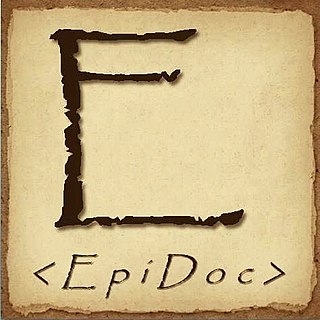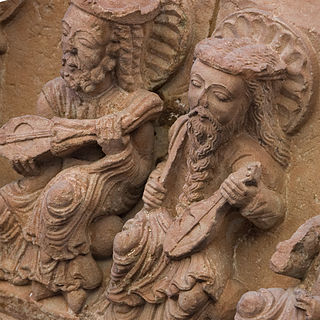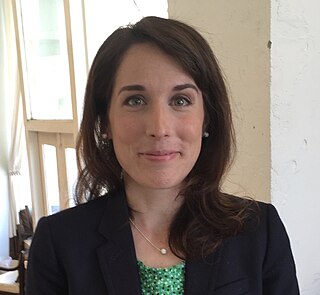Related Research Articles

Acantha is often claimed to be a minor character in Greek mythology whose metamorphosis was the origin of the Acanthus plant. Acantha's myth however does not appear in any classical source.

Alpheus or Alpheios, was in Greek mythology a river and river god.
The Perseus Digital Library, formerly known as the Perseus Project, is a free-access digital library founded by Gregory Crane in 1987 and hosted by the Department of Classical Studies of Tufts University. One of the pioneers of digital libraries, its self-proclaimed mission is to make the full record of humanity available to everyone. While originally focused on the ancient Greco-Roman world, it has since diversified and offers materials in Arabic, Germanic, English Renaissance literature, 19th century American documents and Italian poetry in Latin, and has sprouted several child projects and international cooperation. The current version, Perseus 4.0, is also known as the Perseus Hopper, and is mirrored by the University of Chicago.
A Greek–English Lexicon, often referred to as Liddell & Scott or Liddell–Scott–Jones (LSJ), is a standard lexicographical work of the Ancient Greek language originally edited by Henry George Liddell, Robert Scott, Henry Stuart Jones, and Roderick McKenzie and published in 1843 by the Oxford University Press.
The Thesaurus Linguae Graecae (TLG) is a research center at the University of California, Irvine. The TLG was founded in 1972 by Marianne McDonald with the goal to create a comprehensive digital collection of all surviving texts written in Greek from antiquity to the present era. Since 1972, the TLG has collected and digitized most surviving literary texts written in Greek from Homer to the fall of Constantinople in 1453 CE, and beyond. Theodore Brunner (1934–2007) directed the project from 1972 until his retirement from the University of California in 1998. Maria Pantelia, also a classics professor at UC Irvine, succeeded Theodore Brunner in 1998, and has been directing the TLG since. TLG's name is shared with its online database, the full title of which is Thesaurus Linguae Graecae: A Digital Library of Greek Literature.
Richard John Alexander Talbert is a British-American contemporary ancient historian and classicist on the faculty of the University of North Carolina at Chapel Hill, where he was William Rand Kenan, Jr., Professor of History and is currently Research Professor in charge of the Ancient World Mapping Center. Talbert is a leading scholar of ancient geography and ideas of space in the ancient Mediterranean world.

EpiDoc is an international community that produces guidelines and tools for encoding in TEI XML scholarly and educational editions of ancient documents, especially inscriptions and papyri.
Beta Code was a method of representing, using only ASCII characters, the characters, accents, and formatting found in ancient Greek texts. Its aim was to be not merely a romanization of the Greek alphabet, but to represent faithfully a wide variety of source texts – including formatting as well as rare or idiosyncratic characters. For most applications, it has been obsoleted by unicode.

The Digital Classicist is a community of those interested in the application of digital humanities to the field of classics and to ancient world studies more generally. The project claims the twin aims of bringing together scholars and students with an interest in computing and the ancient world, and disseminating advice and experience to the classics discipline at large. The Digital Classicist was founded in 2005 as a collaborative project based at King's College London and the University of Kentucky, with editors and advisors from the classics discipline at large.
The Greek-language inscriptions and epigraphy are a major source for understanding of the society, language and history of ancient Greece and other Greek-speaking or Greek-controlled areas. Greek inscriptions may occur on stone slabs, pottery ostraca, ornaments, and range from simple names to full texts.
Allen Ross Scaife was a Professor of Classics at the University of Kentucky.

Digital Medievalist is an academic project and community-building organization for those who are interested in the use of computers and computational techniques in the academic field of medieval studies, a sub-field of digital humanities.
In philology, a commentary is a line-by-line or even word-by-word explication usually attached to an edition of a text in the same or an accompanying volume. It may draw on methodologies of close reading and literary criticism, but its primary purpose is to elucidate the language of the text and the specific culture that produced it, both of which may be foreign to the reader. Such a commentary usually takes the form of footnotes, endnotes, or separate text cross-referenced by line, paragraph or page.
Karla Pollmann is the President at the University of Tübingen in Germany, an office she has held since October 1, 2022. Previously she was the Dean of Arts at the University of Bristol, where she worked in both the department of Classics and Ancient History and the department of Religion and Theology. Her research covers Classical to Late Antiquity, patristics, the history of exegesis and hermeneutics, and the thought of Augustine of Hippo and its reception.
The Thesaurus Linguae Aegyptiae is an online dictionary and text corpus of the Egyptian language developed by the Research Centre for Primary Sources of the Ancient World at the Berlin-Brandenburg Academy of Sciences and Humanities (BBAW) in Berlin, Germany. Intended to be a complete documentation of the Egyptian lexicon, it encompasses varied meanings of words in different texts over 3000 years of linguistic history. The dictionary is entirely based on primary source material, including inscriptions from temple walls, roads, tombs, papyri, and potsherds from religious, legal, administrative, and literary texts. The Thesaurus Linguae Aegyptiae is publicly available on the internet. It is a publication of two academy's projects at the Berlin-Brandenburg Academy of Sciences and Humanities and the Saxon Academy of Sciences and Humanities.
The Alpheios Project is an open source initiative originally focused on developing software to facilitate reading Latin and ancient Greek. Dictionaries, grammars and inflection tables were combined in a set of web-based tools to provide comprehensive reading support for scholars, students and independent readers. The tools were implemented as browser add-ons so that they could be used on any web site or any page that a user might create in Unicoded HTML.

Nisa, also Nyssa (Νύσσα) or Nysa (Νύσα) or Neisa (Νείσα), was a town in ancient Lycia near the source of the River Xanthus.

Ernest Stewart Roberts was born in Swineshead, Lincolnshire; a classicist and academic administrator. He served as Master of Gonville and Caius College, Cambridge and Vice-Chancellor of the University of Cambridge (1906-1908). He was admitted to Caius in 1865, elected Fellow in 1870 then Senior Tutor. He was elected President in 1894 and Master in 1903. He was involved in the foundation of the College magazine, The Caian and the College Mission at Battersea and in the organisation of the College rifle corps and boat club.
Irene J. F. de Jong is a classicist and professor of Ancient Greek at the University of Amsterdam. She is known for her pioneering work on narratology and Ancient Greek literature. She is a Fellow of the British Academy.

Sarah Emily Bond is a Professor of History at the University of Iowa. Her research focuses on late Roman history, epigraphy, law, topography, GIS, and digital humanities.
References
- ↑ Arguably, the first references to the use of computing to study a text in a classical language are to a project at IBM to create a computer generated concordance of Aquinas beginning in 1949; for this, see Theodore F. Brunner, "Classics and the Computer: The History of a Relationship," in Accessing Antiquity: The Computerization of Classical Studies (1993), ed. Jon Solomon, Tucson: U. Arizona Press, for a general introduction to the early history of computing in the classical humanities.
- ↑ See also: Busa, Roberto. (1980). ‘The Annals of Humanities Computing: The Index Thomisticus’, in Computers and the Humanities 14:83-90. The Index Thomisticus is arguably the first humanities computing project and this seminal article deals specifically with the digitisation of this Latin text as well as reflecting on the nature and purpose of this field of scholarship.
- ↑ e.g. http://stephanus.tlg.uci.edu/history.php Archived 2012-11-18 at the Wayback Machine for the history of this project
- ↑ See, e.g., the projects listed at http://www.kcl.ac.uk/cch/research/projects.html or http://jefferson.village.virginia.edu/iathrails/projects/homepage Archived 2007-02-16 at the Wayback Machine
- ↑ See http://ccat.sas.upenn.edu/bmcr/about.html for information on the history and scope of this publication
- ↑ The Perseus Project was originally published on the HyperCard platform in 1990 — around the time of the invention of the World Wide Web; see archival versions of the Perseus 1.0 documentation, http://vanth.perseus.tufts.edu/Help/P1/Doc1.info.html%5B%5D and the Platform-Independent Perseus documentation, http://vanth.perseus.tufts.edu/Help/PIP2/Goals_Help.html%5B%5D, Mylonas, "The Perseus Project," http://xml.coverpages.org/mylonasPerseus.html, and Mylonas, Crane, Morrell, and Smith, "The Perseus Project: Data in the Electronic Age" in Solomon, Accessing Antiquityop. cit. for information toward a history of Perseus' use of hypertext platforms and other information infrastructures.
- ↑ See http://wiki.digitalclassicist.org/Main_Page
- ↑ See https://epigraphy.info/
- ↑ See http://www.lsoft.com/scripts/wl.exe?SL1=CLASSICISTS&H=LISTSERV.LIV.AC.UK for details